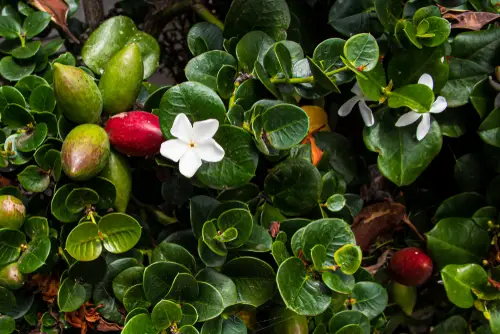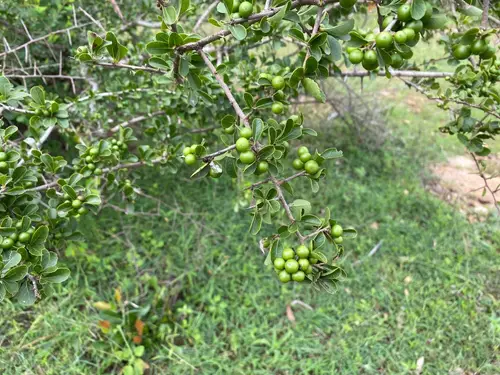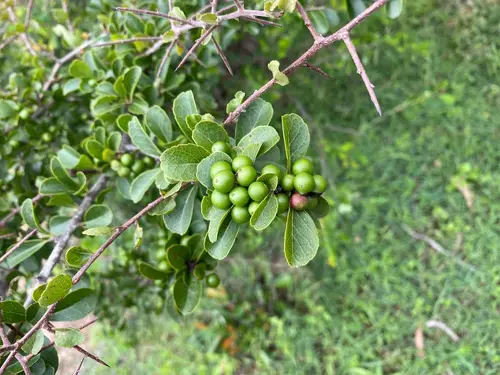The Num Num plant, also known as Carissa Macrocarpa, is a thorny shrub that is native to the coastal regions of South Africa. It is a popular ornamental plant that is widely grown for its fragrant white flowers and sweet-tasting red fruit. Despite its popularity, many people are not aware of where to find the Num Num plant.
The Num Num plant can be found in a variety of habitats, including coastal dunes, forests, and scrublands. It is a hardy plant that can tolerate a wide range of soil types and growing conditions. In South Africa, it is commonly used as a hedge plant due to its thorny nature, which makes it an effective barrier for livestock and wildlife.
If you are interested in finding the Num Num plant, there are several resources available to help you locate it. Local nurseries and garden centers often carry the plant, and it can also be purchased online from a variety of retailers.
Additionally, many botanical gardens and arboretums feature the Num Num plant in their collections, providing an opportunity to see it in person and learn more about its unique characteristics.
Key Takeaways on Where Can You Find The Num Num Plant?
- The Num Num plant is native to the coastal regions of South Africa and can be found in a variety of habitats.
- The plant is commonly used as a hedge and can be purchased from local nurseries, garden centers, and online retailers.
- Botanical gardens and arboretums often feature the Num Num plant in their collections, providing an opportunity to see it in person and learn more about its unique characteristics.
See these other popular picks in this category:
- Where Can I Buy VF-11 Plant Food?
- Where Can I Get a Jasmine Plant?
- When to Plant Caladium Bulbs in Houston?
Understanding the Num Num Plant

The num num plant is a shrub that is native to the coastal regions of the KwaZulu-Natal province of South Africa. It belongs to the Apocynaceae family and is scientifically known as Carissa macrocarpa. It is also commonly referred to as the Natal plum, big num-num, or large num-num.
This evergreen shrub is known for its fast-growing nature and can grow up to 3 meters in height. The branches of the num num plant are spiny and bear shiny, deep green leaves that are heart-shaped. The glossy foliage of the num num plant makes it an ornamental plant that is often used as a hedge or screening plant.
The num num plant produces fragrant white star-shaped flowers that bloom in spring and summer. The flowers are followed by red, sweet-tasting fruit that is edible and has a flavor similar to cranberries. In South Africa, the fruit is commonly known as noem-noem.
Another species of the num num plant is Carissa bispinosa, which is also known as the forest num-num or bosnoemnoem. This spiny shrub is an ornamental plant that is grown for its glossy foliage and fragrant white flowers. It is native to the eastern regions of southern Africa and is commonly found in forests and bushveld areas.
Origins and Habitat
The num num plant, also known as Carissa macrocarpa or Carissa bispinosa, is native to southern Africa, particularly in the coastal regions of KwaZulu-Natal province in South Africa. It is commonly found in coastal forests and is known to tolerate salt-laden winds, making it a popular choice for coastal landscaping.
The plant is also found in other parts of southern Africa, including Zimbabwe and Mozambique. In Kenya, the plant is known as “amathungulu” or “umthungulu obomvu” in Zulu. It is also found in the Eastern Cape province of South Africa.
The num num plant is a hardy evergreen shrub that can grow up to 5 meters tall. It thrives in subtropical climates and prefers well-drained soil. The plant produces fragrant white flowers and edible red fruit that is sweet and juicy.
The num num plant has been introduced to other parts of the world, including Florida and California in the United States, where it is grown as an ornamental plant. However, it is important to note that the plant can be invasive in some areas and should be planted with caution.
Physical Attributes
The num num plant is a spiky-stemmed shrub that grows up to 3 meters tall. It has glossy, dark green leaves that are oval-shaped and leathery to the touch. The plant produces snowy white flowers that are star-shaped and have a sweet fragrance. These flowers are about 2.5 cm in diameter and bloom in clusters from late spring to early summer.
The num num plant also produces small, red, sweet-tasting fruit that is edible and can be eaten raw or cooked. The fruit is about 2-3 cm in diameter and has a thin, tough skin. It contains small, hard seeds that are surrounded by a juicy pulp. The fruit is high in vitamin C and antioxidants.
The plant has forked spines that grow from the base of the leaves. These spines are about 1-2 cm long and can be sharp, so it is important to handle the plant with care. The num num plant also has a milky sap that can cause skin irritation in some people.
The num num plant is commonly found in coastal regions of South Africa, particularly in the KwaZulu-Natal province. It grows well in sandy soils and can tolerate salt-laden winds, making it a good choice for coastal gardens. The plant is often used as a hedge and can be pruned to create a dense, bushy shape.
Cultivation and Care

The Num Num plant, also known as Carissa macrocarpa, is a hardy and drought-resistant plant that can be grown in a variety of conditions. Here are some tips for cultivating and caring for this beautiful plant:
1. Soil
Num Num plants prefer well-drained soil that is slightly acidic with a pH between 5.5 and 6.5. Sandy soil is ideal, but they can also grow in loamy soil with good drainage. They are tolerant of limestone and alkaline soils, but it is best to avoid soils that are too heavy or prone to root rot.
2. Sunlight
Num Num plants prefer full sun to semi-shade, but they can also tolerate heavy shade. In areas with hot summers, it is best to provide some shade during the hottest part of the day.
3. Watering
Num Num plants are drought-resistant and do not require frequent watering. They can tolerate short periods of drought, but it is important to water them deeply when the soil is dry to the touch.
4. Fertilizing
Num Num plants do not require heavy fertilization. A light application of compost or a balanced fertilizer in the spring can help promote growth and flowering.
5. Pruning
Num Num plants can be pruned to maintain their shape and size. Prune in the late winter or early spring before new growth appears. Remove any dead or damaged branches, and trim back any branches that are growing too long.
6. Propagation
Num Num plants can be propagated from seeds or cuttings. Vegetative propagation from cuttings is the preferred method, as it produces plants that are true to the parent plant.
7. Hardy
Num Num plants are hardy and can tolerate a wide range of conditions. They are tolerant of winds and salt spray, making them a good choice for coastal gardens.
8. Nutrients
Num Num plants require calcium, magnesium, and phosphorus for healthy growth. A balanced fertilizer can provide these nutrients, or you can add amendments to the soil as needed.
The Num Num Plant and Wildlife

The Num Num plant, also known as Carissa bispinosa, is a species of flowering plant that is native to South Africa, Mozambique, Malawi, Swaziland, and Zimbabwe. This evergreen plant is found in wooded areas, bushveld, coastal regions, and forests, and it forms dense bushes that can be used as ornamental plants or hedges.
The plant has fragrant flowers with a white corolla, and it produces red fruits when ripe. The fruit is edible and is often used to make jams and jellies. The plant is also used in traditional medicine to treat various ailments such as fever, coughs, and stomach problems.
The Num Num plant plays an important role in the ecosystem by providing food and shelter for various wildlife species. Birds such as the Cape Robin-chat, the Black-eyed Bulbul, and the Olive Thrush feed on the fruit of the plant, while insects such as bees and butterflies are attracted to its flowers.
Monkeys are also known to feed on the fruit of the plant. The plant is also used as a host for the larvae of the Citrus Swallowtail butterfly, which feeds on its leaves. The butterfly is an important pollinator of various plant species, including citrus trees.
Uses of the Num Num Plant
The Num Num plant, also known as Carissa macrocarpa, is a versatile plant that has various uses. It is native to the coastal regions of the KwaZulu-Natal province of South Africa and is commonly used for its edible fruit, ornamental value, and security hedge.
1. Edible Fruit
The fruit of the Num Num plant is edible and has a sweet taste. It is commonly used to make jams, jellies, and sauces. The fruit can also be eaten raw or used in baking, pies, and salads. The fruit is rich in pectin, which makes it suitable for making jams and jellies.
2. Ornamental Value
The Num Num plant has an ornamental value and is commonly used as a hedge or bonsai tree. It has glossy green leaves, fragrant white star-shaped flowers, and red edible fruit. The plant can be pruned to form a dense, impenetrable hedge, which makes it a popular choice for security hedges.
3. Traditional Uses
The Num Num plant has been used for traditional medicinal purposes. The roots and bark of the plant have been used to treat various ailments such as toothache, stomach problems, and snake bites. However, it is important to note that the plant is poisonous and should not be ingested unless properly prepared.
4. Culinary Uses
The fruit of the Num Num plant is used in various culinary applications. It is commonly used to make jams, jellies, and sauces. The fruit can also be eaten raw or used in baking, pies, and salads. The fruit has a similar taste to a combination of strawberry, cherry, and cranberry.
Nutritional Value

The Num Num fruit is a rich source of vitamins and minerals, making it a healthy addition to any diet. It is especially high in Vitamin C, which is essential for a healthy immune system. A single serving of Num Num fruit contains more Vitamin C than an orange.
In addition to being high in Vitamin C, Num Num fruit is also a good source of iron. Iron is important for the production of red blood cells and helps to prevent anemia.
The fruit is also rich in other important nutrients, including calcium, magnesium, and phosphorus. These minerals are essential for strong bones and teeth.
Num Num fruit is also high in pectin, which is a type of soluble fiber. Soluble fiber helps to lower cholesterol levels and promotes healthy digestion.
Medicinal Uses
The num num plant has been used for medicinal purposes for centuries. The plant is known to have various medicinal properties and has been used to treat a range of ailments.
One of the most common uses of the num num plant is for the treatment of toothache. The latex from the plant has been used for centuries as a natural remedy for toothache. The latex is applied directly to the affected tooth and is said to provide quick relief from pain.
In addition to treating toothache, the num num plant is also commonly used to treat earache. The leaves of the plant are crushed and the juice is extracted. The juice is then applied directly to the affected ear. The plant is known to have anti-inflammatory properties, which can help to reduce inflammation and relieve pain.
The num num plant has also been used to treat a range of other ailments, including diarrhea, dysentery, and stomach ulcers. The plant is known to have antibacterial and antifungal properties, which can help to fight off harmful bacteria and fungi in the body.
It is important to note that while the num num plant has been used for medicinal purposes for centuries, there is limited scientific evidence to support its effectiveness. It is always recommended to consult with a healthcare professional before using any natural remedies for medicinal purposes.
Other Names
The num num plant is known by various names in different regions. In South Africa, it is commonly referred to as the large num-num, while in Zulu, it is called Amathungulu or umThungulu oBomvu. The Afrikaans name for the fruit is noem-noem, which means “name-name.”
The plant is also known as Natal plum due to its origin in tropical and southern Africa. The scientific name for the plant is Carissa macrocarpa, and it belongs to the Apocynaceae (dogbane) family.
In India, the plant is known as “Karu Nerale Hannu” in Kannada, which means “black jam fruit.” It is also called “Karu Nerale” or “Karanda” in other parts of India. The plant is popular in India due to its medicinal properties, and it is used to treat various ailments such as coughs, colds, and stomach disorders.
The num num plant has a unique and exotic look, with dark green, closely set, and leathery oval leaves. It bears fragrant white blossoms and an edible red berry called Noem-Noem. The fruit is sweet and juicy and can be eaten raw or used to make jams and jellies.
Frequently Asked Questions

What are the benefits of growing and eating Num Num plants and fruit?
Num Num plants are not only ornamental but also provide edible fruit that is rich in vitamin C and antioxidants. The fruit has a sweet taste and can be eaten raw or used in jams and jellies. Additionally, the plant has medicinal properties and is used to treat various ailments in traditional medicine.
Where can I purchase Num Num plants?
Num Num plants can be purchased at local nurseries or online gardening stores. It is important to ensure that the plant is sourced from a reputable supplier and that it is suitable for the local climate.
Where can I find Num Num berries for consumption?
Num Num berries can be found on the plant itself when it is in season. They are also sold at some local markets and specialty food stores.
How can I grow a Num Num hedge?
To grow a Num Num hedge, it is important to plant the shrubs at regular intervals and to ensure that they receive adequate sunlight and water. The plants can be pruned to maintain the desired shape and size.
What are the medicinal uses of Carissa macrocarpa?
Carissa macrocarpa, also known as Num Num, has been used in traditional medicine to treat a variety of ailments including stomach issues, fever, and skin conditions. However, it is important to consult with a healthcare professional before using any natural remedies.
Are Num Num berries safe to eat?
Num Num berries are safe to eat in moderation. However, it is important to note that the plant contains toxins and should not be consumed in large quantities. It is also important to properly wash and prepare the fruit before consumption.

Hey, I’m Lisa and I’ve been an avid gardener for over 30 years. I love writing, talking and living in the garden! Feel free to connect with me on my socials below

